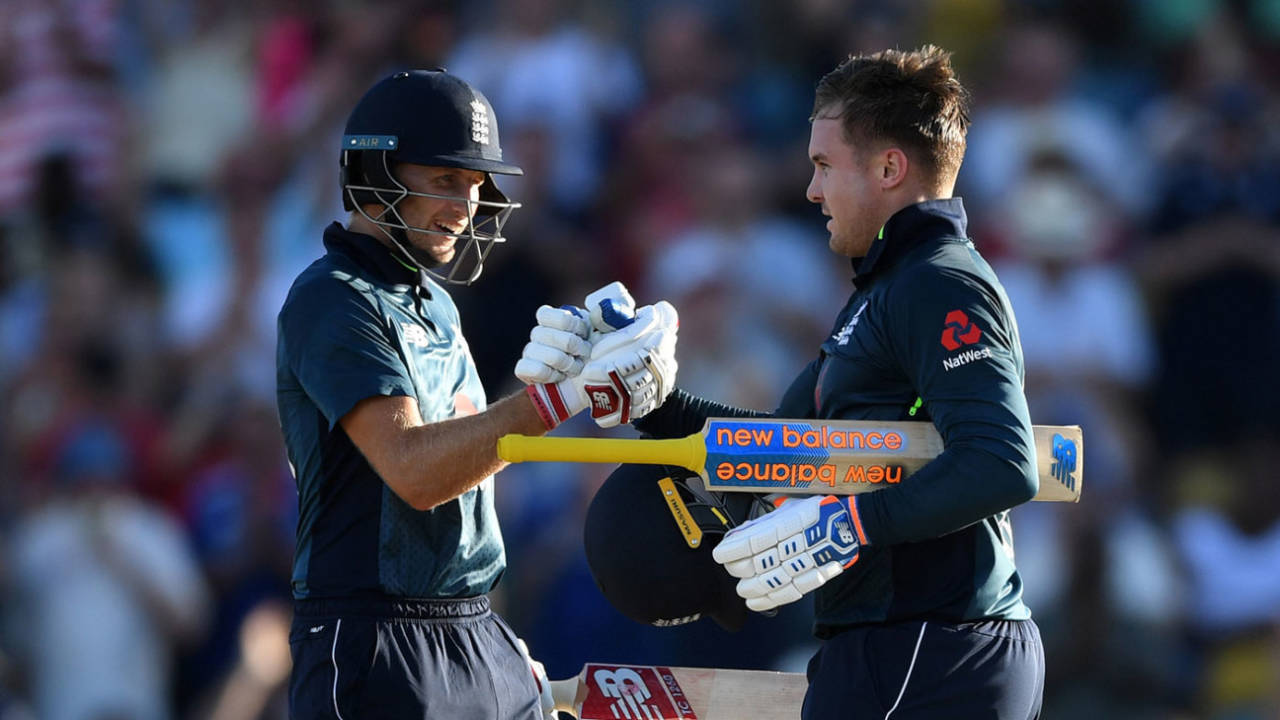England lead chasing pack but attacking blueprint has its flaws
They have become the most fearsome ODI side in the world batting second but England's boom-or-bust approach could still undermine them at the World Cup
Alan Gardner
04-Mar-2019
Joe Root congratulates Jason Roy on his century • Getty Images
What to make of all that, then? West Indies and England went at each other like a couple of punch-drunk heavyweights through four ODIs (one was washed out), at the end of which the side ranked No. 9 in the world had held No. 1 to a 2-2 draw. There were 103 sixes struck - second only to the 2013-14 series between India and Australia, which featured two more matches - including a world-record 46 in Grenada; we saw a successful pursuit of 361, a shaky defence of 418, and a complete capitulation to end the series.
For England, considered by many as front-runners for the World Cup, there was cause for concern. Having pulled off their highest successful chase at a canter in Barbados, they then stumbled in the face of a less daunting 290 at the same ground. No sooner had they piled up their fourth 400-plus score since the last World Cup (and narrowly survived a Chris Gayle-inspired onslaught in reply), they plummeted to their lowest ODI total since being bowled out for 99 against Sri Lanka back in the Dark Ages of 2014.
If there was any clear conclusion to be drawn, it was in the difficulty of assessing a par score batting first in this new era of limitless hitting. Only once in five tosses did a captain elect to put runs on the board - Jason Holder in the first match - although another quirk of the series was that only in St Lucia did winning the toss lead to winning the match.

England's record total displayed on the Trent Bridge scoreboard•Getty Images
This, by the way, seems to be a phenomenon associated with England, and the way they have warped ODI cricket. While the percentage of teams electing to chase has dropped overall, from 54% in the four years before the last World Cup, to 46% since, Eoin Morgan has gone completely the other way - opting to bat first only 11 times from 33 tosses won. And Morgan's preference becomes clear when you crunch the numbers.
While England's batting explosion has been sliced and diced in various ways, an aspect that may have been overlooked is their proficiency at hunting down a target - understandable when it is skyscraping scores batting first, such as the 481 for 6 at Trent Bridge last summer, that make headlines.
A win/loss ratio of 3.625 when chasing over the last four years is way in excess of the next best - India at 2.357 - and more than double every other side. Their record has taken a couple of recent dents, too, having failed to chase in the second ODI against West Indies, as well as suffering a major collapse in the final match of their series in Sri Lanka; but between March 2017 and last October, England won an extraordinary 17 out of 18 ODIs batting second (the one defeat coming after they conceded 371 against Scotland).
This strength was highlighted by England's victory in the first ODI in Barbados, when they pulled off the third-highest successful chase ever with six wickets and eight balls to spare. That was the seventh time since the 2015 World Cup they have successfully overhauled a 300-plus target - previously, they had only managed it twice in their ODI history - while no other team has done so more than three times.
England are also the only team to score at more than a run a ball when chasing, and when the stakes are raised further, their aggression again separates them from the pack: in pursuits of 320-plus, five times out of six, England have either won, or lost by a margin of fewer than 20 runs. Their average score in such innings has been 324. India, next-best overall, remember, have only got so close in four out of nine 320-plus chases, with an average score of 287.
And while Virat Kohli is the master chaser, marginally ahead of team-mate Rohit Sharma, England have four of the 12 batsmen to have scored 1000 runs batting second since the last World Cup: Jason Roy, Joe Root, Morgan and Jonny Bairstow.
Of course, these numbers in part reflect England's relative weakness with the ball - they have the second-worst bowling economy over the time period in question - as well as a recurring vulnerability when conditions are less conducive to all-out attack.
As many times as England have gone past 400 batting first, they have also been bowled out for below 200: blips at Old Trafford and Lord's, Adelaide and St Lucia that have called into question their ability to adapt. Then there is the example of the 2017 Champions Trophy, when Pakistan's mastery of a slower surface led to England being knocked out despite their status as favourites. When having to set the pace, their win/loss ratio dips to 1.600, significantly lower than India (2.200) and comparable to South Africa (1.538) and New Zealand (1.470).
With the World Cup now just a few months away, Morgan and his men will doubtless be happy to return to home conditions and focus on trying to claim that elusive bit of 50-over silverware. But while England have become the world's gun chasing side, as the series in the West Indies showed, the game is rarely that simple.
With inputs from Bharath Seervi and Shiva Jayaraman. Stats correct up to March 3, 2019
Alan Gardner is a deputy editor at ESPNcricinfo. @alanroderick
